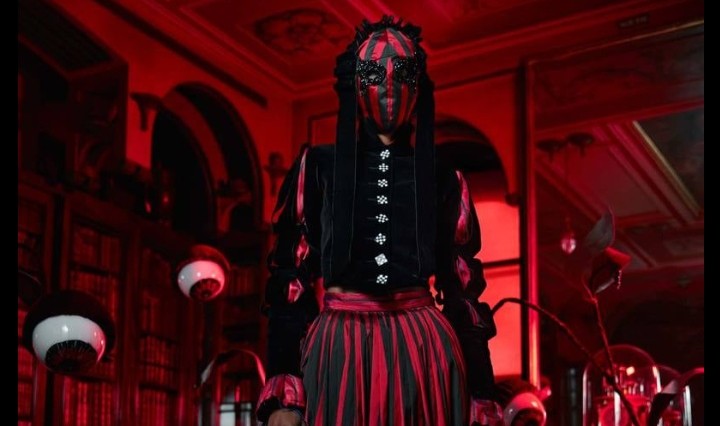
Source: Ghanaija
In the vibrant city of Lagos, Nigeria, young designer Adaobi stood in front of her mirror, carefully applying dark lipstick and adjusting her black lace dress. She had always been fascinated by goth fashion, an interest that set her apart in a culture brimming with colorful fabrics and intricate designs. As she prepared for the local fashion show, Adaobi reflected on the rich history and origin of the goth fashion movement, tracing its roots from 18th-century Europe to its global influence today.
The story of goth fashion begins in the late 1970s and early 1980s with the rise of the goth subculture. This subculture evolved from the punk rock scene, primarily in the United Kingdom. Bands like Siouxsie and the Banshees, Joy Division, and Bauhaus were pivotal in shaping the music that influenced the goth aesthetic. Bauhaus’s song “Bela Lugosi’s Dead,” released in 1979, is often credited as the defining anthem of the goth movement.
In Nairobi, Kenya, James, a historian and music enthusiast, often hosted discussions about subcultures at his small café. During one of these sessions, he delved into how goth fashion began as an expression of the themes present in goth music. These themes included darkness, romanticism, and a fascination with the macabre. The attire reflected these motifs, characterized by dark clothing, dramatic makeup, and a penchant for Victorian and Edwardian styles. Black was the dominant color, symbolizing mystery and rebellion.
James highlighted the significance of the Victorian era in shaping goth fashion. The Victorian fascination with death and mourning rituals heavily influenced the goth look. Mourning attire, which was elaborate and dark, became a staple in goth wardrobes. Women in the goth community often wore long, flowing dresses made of velvet or lace, accessorized with corsets and elaborate jewelry. Men typically sported dark suits, often inspired by the attire of historical figures like Lord Byron.
Across the continent in Johannesburg, South Africa, Lerato, a young fashion blogger, explored how goth fashion made its way from Europe to other parts of the world, including Africa. She wrote about how the movement maintained its core elements while adapting to different cultural contexts. In Africa, goth fashion was embraced by individuals who resonated with its themes of individuality and non-conformity. Local designers began incorporating traditional African elements into goth attire, creating unique fusion styles.
In Cairo, Egypt, Khaled, a fashion designer, found inspiration in blending goth fashion with ancient Egyptian motifs. He created collections that featured dark, flowing garments adorned with hieroglyphic prints and jewelry reminiscent of ancient pharaohs. Khaled’s work demonstrated how goth fashion could be both global and deeply rooted in local culture.
Goth fashion continued to evolve through the decades. In the 1990s, it saw a resurgence with the popularity of bands like Nine Inch Nails and Marilyn Manson. This era introduced industrial and cyber-goth elements, incorporating more futuristic and synthetic materials into the fashion. The goth aesthetic expanded to include fishnet stockings, platform boots, and neon accents.
In Accra, Ghana, Ama, a university student studying fashion design, became fascinated by the versatility of goth fashion. She admired how it could seamlessly blend different eras and influences. Ama’s designs often featured traditional Ghanaian fabrics in dark hues, combined with the dramatic silhouettes typical of goth attire. Her work was a testament to the adaptability of the goth aesthetic.
The internet age brought about a new wave of goth fashion enthusiasts. Online communities and social media platforms allowed individuals from around the world to connect, share ideas, and showcase their unique styles. In Dar es Salaam, Tanzania, Amina, a digital content creator, used her platform to educate her followers about the history of goth fashion. She emphasized how the movement was not just about clothing but also about expressing one’s identity and emotions.
Amina also explored how goth fashion intersected with other subcultures. She noted how the Lolita fashion movement in Japan incorporated goth elements, resulting in the Gothic Lolita style, which combined dark Victorian-inspired attire with a doll-like aesthetic. This cross-cultural exchange highlighted the global reach and influence of goth fashion.
Back in Lagos, Adaobi’s fashion show was a success. Her collection, which fused traditional Nigerian patterns with gothic elements, received rave reviews. Adaobi had managed to honor the origins of goth fashion while adding her unique cultural touch. Her designs featured intricate beadwork, often seen in Nigerian attire, integrated into dark, flowing dresses. The combination of these elements created a visually striking contrast that captivated the audience.
As Adaobi stood on the stage, receiving applause, she felt a deep connection to the global community of goth fashion enthusiasts. She realized that goth fashion was more than just a style; it was a way of life that transcended borders and brought people together through a shared appreciation for the beauty in darkness and the complexity of human emotions.
In conclusion, goth fashion has a rich and diverse history that spans continents and cultures. From its origins in the punk rock scene of the UK to its adaptation in various parts of Africa, goth fashion continues to evolve and inspire. It remains a powerful form of self-expression, allowing individuals like Adaobi, James, Lerato, Khaled, Ama, and Amina to explore their identities and connect with others through their unique interpretations of this enduring aesthetic.








